🦠 Diseases
Diseases and Vaccination of Pigs
Which of the following statement is correct?
African Swine Fever (ASF)
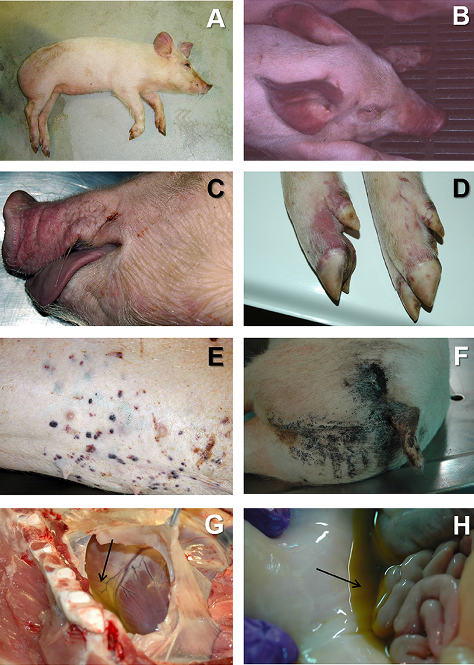
- It is a highly contagious and fatal
viraldisease of domestic and wild pigs. - ASF was detected first in 1921 in Kenya and is generally prevalent and endemic in countries of sub-Saharan Africa, Europe and in some Caribbean countries.
- India notified the first outbreak of ASF virus in January, 2020 in the North Eastern States of Assam and Arunachal Pradesh.
- African swine fever (ASF) has become a major crisis for the pork industry in recent years.
- The disease can result in up to 100% fatalities in a population.
- It is transmitted through direct and indirect contacts, ingestion of contaminated feedstuffs and by certain tick vector species.
- The disease does not infect humans (not Zoonotic) or other livestock species.
- No vaccine or drugs are available to prevent ASF infection at present.
- Symptomes:
- High fever 40-42°C.
- Loss of appetite.
- Depression.
- Lethargic- sometimes refusal to stand or move.
- Vomiting and/or diarrhoea with bloody discharge.
- White skinned pigs: extremities (nose, ears, tail and lower legs) become cyanotic (blue-purple colour).
- Discrete haemorrhages appear in the skin particularly on the ears and flanks.
Classical Swine Fever

- It is highly contagious
viraldisease of domestic and wild pigs. - Also known as hog cholera or pig plague.
- Young animals more susceptible.
- In the acute form of the disease, in all age groups, there is fever, huddling of sick animals, loss of appetite, dullness, weakness, conjunctivitis, constipation followed by diarrhoea, and an unsteady gait.
- Several days after the onset of clinical signs, the ears, abdomen and inner thighs may show a purple discoloration.
- Animals with acute disease die within 1–2 weeks. (High mortality)
- Modified live vaccines (MILV) are used to control CSF.
Swine Influenza
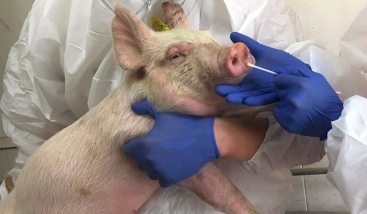
- Swine influenza is a highly contagious
respiratory viralinfection of pigs caused by swine influenza virus. - It is characterized by coughing, sneezing, nasal discharge, elevated rectal temperatures, lethargy, difficult breathing, depressed appetite and rarely associated with reproductive disorders such as abortion.
Porcine Parvo Virus (PPV)
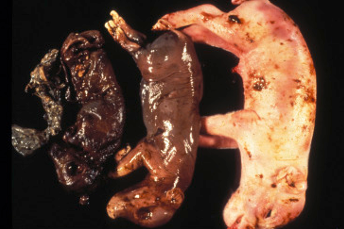
- Porcine parvovirus infection (PPV) is a common and important cause of infectious infertility.
- If pregnant sows become infected with Porcine Parvovirus (PPV) causes reproductive failure.
- An increased numbers of stillbirths. These are associated with the delay in the farrowing mechanism which occurs because of the presence of mummified piglets.
- Small litters associated with embryo loss before 35 days gestation.
- An increase in low birth weight piglets but neonatal deaths are not affected.
- Small mummified piglets in the afterbirth present.
Exudative Dermatitis
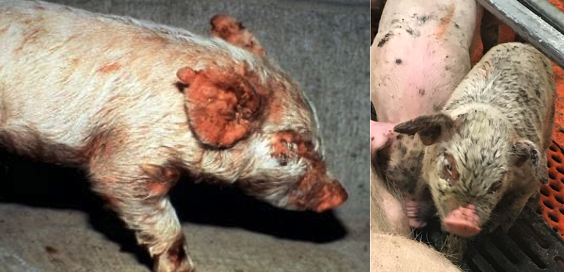
- Also knonw as
Greasy pig. - The symptoms of this disease are skin lesions caused by an infection of the
bacteriaStaphlococcus hyicus.
Coccidiosis

- This is a
protozoandisease. - This disease is very common in suckling piglets and is caused by intracellular
parasite protozoa coccidia. - Diarrhoea, which may become bloody in severe cases, is the primary symptom.
Swine Dysentery (SD)
BacteriaBrachyspira hyodysenteriae (B. hydo)- Infectious disease characterized by mucohemorrhagic diarrhoea and marked inflammation limited to the large intestine.
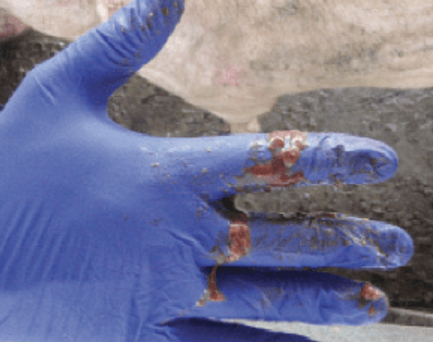
- Soft to watery faeces are common first signs.
- Diarrhoea, usually with mucus and/or blood as signs progress.
- Uneven pig growth, increased mortality, and significantly reduced feed efficiency are seen as disease progresses.
Piglet Anemia
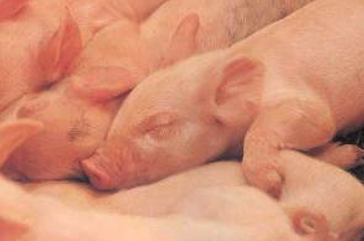
- Newborn piglets have only limited reserve of iron in the liver for hemoglobin synthesis.
- This is due to poor placental transfer of iron to foetus.
- Also the sow milk is very low in iron, and the suckling pig should be supplemented with iron during the first few days to prevent piglet anemia.
- Symptom: Pale in the region of ears and belly, rapid breathing and diarrhea.
- Control:
- Placing fresh, clean earth in the piglet’s pen each day.
- Daily administration of 4 ml of 1.8 percent ferrous sulphate solution
References
- G.C. Banerjee: A Textbook of Animal Husbandry
- https://agritech.tnau.ac.in/
- https://www.breedslist.com/
- https://nbagr.icar.gov.in/
- Wikipedia
Which of the following statement is correct?
African Swine Fever (ASF)

- It is a highly contagious and fatal
viraldisease of domestic and wild pigs. - ASF was detected first in 1921 in Kenya and is generally prevalent and endemic in countries of sub-Saharan Africa, Europe and in some Caribbean countries.
- India notified the first outbreak of ASF virus in January, 2020 in the North Eastern States of Assam and Arunachal Pradesh.
- African swine fever (ASF) has become a major crisis for the pork industry in recent years.
- The disease can result in up to 100% fatalities in a population.
- It is transmitted through direct and indirect contacts, ingestion of contaminated feedstuffs and by certain tick vector species.
- The disease does not infect humans (not Zoonotic) or other livestock species.
- No …
Become Successful With AgriDots
Learn the essential skills for getting a seat in the Exam with
🦄 You are a pro member!
Only use this page if purchasing a gift or enterprise account
Plan
Rs
- Unlimited access to PRO courses
- Quizzes with hand-picked meme prizes
- Invite to private Discord chat
- Free Sticker emailed
Lifetime
Rs
1,499
once
- All PRO-tier benefits
- Single payment, lifetime access
- 4,200 bonus xp points
- Next Level
T-shirt shipped worldwide

Yo! You just found a 20% discount using 👉 EASTEREGG

High-quality fitted cotton shirt produced by Next Level Apparel